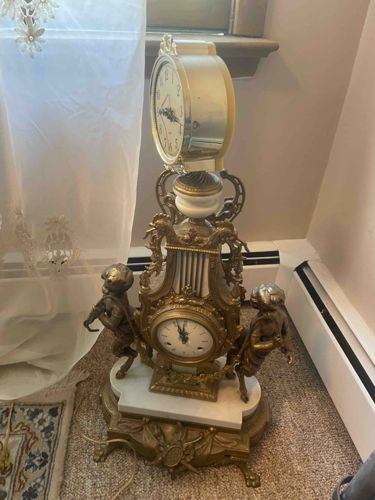
Gilt Bronze and Marble 'Mystery' Clock with Dual Faces
This is a large, ornate mantel or table clock, likely a French gilt bronze and marble 'mystery' clock, given its unusual dual timekeeping faces. The primary construction materials appear to be gilt bronze or brass for the elaborate framework and figures, contrasted with white marble for the base and an intermediary platform. The clock features two distinct clock faces. The lower clock face, integrated into the main body, is round with black Roman numerals and hands, set within a highly decorative, possibly gilded frame. The upper clock face, which is considerably larger, is positioned vertically atop the structure, displaying what appears to be regular Arabic numerals or simple lines for hour markers and hands with a red second hand, encased in a simple, flat gold-toned metal frame. This upper section is connected to the decorative body by a spherical white element and an intricate, possibly scrolling or foliate motif. The main body of the clock is exceptionally ornate, featuring extensive rococo or highly decorative classical revival scrolling foliage, a central fluted or reeded section, and prominently, two putti or cherubic figures flanking the lower clock face. These figures are three-dimensional, detailed, and appear to be cast from the same gilt metal. The base is multi-tiered, with a substantial white marble slab resting on a footed, ornate metal plinth. The overall impression is one of opulence and intricate craftsmanship. There are no visible maker's marks or signatures in the image. The age is estimated to be late 19th to early 20th century, consistent with the elaborate style. The condition appears to be fair to good, with some visible dust accumulation and potential wear to the gilding, possibly also some minor oxidation given its age, but no obvious significant damage like breaks or deep scratches are discernible from the provided image. The quality of the casting and detailing suggests a well-made piece, albeit possibly mass-produced for the luxury market of its era. The 'mystery' aspect comes from the less obvious mechanism for the upper clock face, which sometimes uses hidden gears or a specific type of movement.
AI-Generated Appraisal Disclaimer
Estimated Value
$2,500 - $4,500
Basic Information
Category
Decorative Arts/Timepieces
Appraised On
December 7, 2025
Estimated Value
$2,500 - $4,500
Item Description
This is a large, ornate mantel or table clock, likely a French gilt bronze and marble 'mystery' clock, given its unusual dual timekeeping faces. The primary construction materials appear to be gilt bronze or brass for the elaborate framework and figures, contrasted with white marble for the base and an intermediary platform. The clock features two distinct clock faces. The lower clock face, integrated into the main body, is round with black Roman numerals and hands, set within a highly decorative, possibly gilded frame. The upper clock face, which is considerably larger, is positioned vertically atop the structure, displaying what appears to be regular Arabic numerals or simple lines for hour markers and hands with a red second hand, encased in a simple, flat gold-toned metal frame. This upper section is connected to the decorative body by a spherical white element and an intricate, possibly scrolling or foliate motif. The main body of the clock is exceptionally ornate, featuring extensive rococo or highly decorative classical revival scrolling foliage, a central fluted or reeded section, and prominently, two putti or cherubic figures flanking the lower clock face. These figures are three-dimensional, detailed, and appear to be cast from the same gilt metal. The base is multi-tiered, with a substantial white marble slab resting on a footed, ornate metal plinth. The overall impression is one of opulence and intricate craftsmanship. There are no visible maker's marks or signatures in the image. The age is estimated to be late 19th to early 20th century, consistent with the elaborate style. The condition appears to be fair to good, with some visible dust accumulation and potential wear to the gilding, possibly also some minor oxidation given its age, but no obvious significant damage like breaks or deep scratches are discernible from the provided image. The quality of the casting and detailing suggests a well-made piece, albeit possibly mass-produced for the luxury market of its era. The 'mystery' aspect comes from the less obvious mechanism for the upper clock face, which sometimes uses hidden gears or a specific type of movement.
Get Your Items Appraised
Instant estimates of your treasures with AI-powered instant appraisals